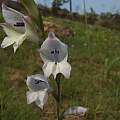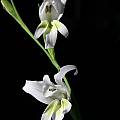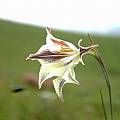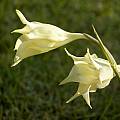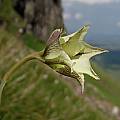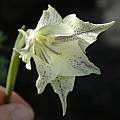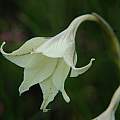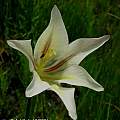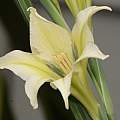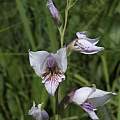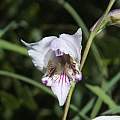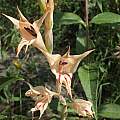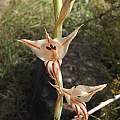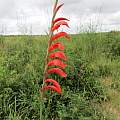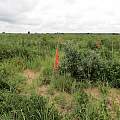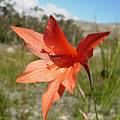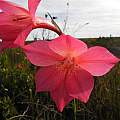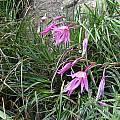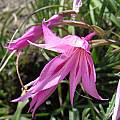Summer rain Gladiolus are mostly from the eastern part of South Africa. They generally like their summers wet and their winters dry, but just exactly how wet and how dry may vary widely depending on on the exact location of origin. Among the summer rain species are some of the most frost hardy of the African species, but as most tropical African Gladiolus follow a summer rain pattern as well, some are quite frost tender.
Page 1: G. albens... Page 2: G. densiflorus... Page 4: G. mortonius... Page 5: G. rehmannii... Page 6: G. sericeovillosus...
Gladiolus inandensis Baker is a species that grows in small clumps to 20 to 45 cm. It is mostly found on sandstone soils in KwaZulu-Natal and the Eastern Cape, but it also has been recorded in Lesotho. Plants are found on rocky grassland and flower early in the summer rainfall region, mostly July to August, extending into September. This species has small white to cream flowers flushed with purple on the outside of the tepals. The dorsal tepal is hooded over the stamens. This species is unusual in that the flowers are usually produced before the new leaves on short stems with the dry dead previous foliage leaves attached to their base. This species is very similar to Gladiolus wilsonii but that species produces a stem after the new leaves are produced and flowers at a different time. Photo from Rachel Saunders.
Gladiolus involutus D.Delaroche is found on clay slopes in renosterveld and grassland in areas with summer and winter rainfall. Flowering from winter into spring, it has white flowers with yellow-green markings on the lower tepals. Photo by Bob Werra.
Gladiolus longicollis Baker is a species found in a wide area of southern Africa, including the southern Cape, the eastern Cape, the Free State and the Northern Province. It has pale yellow to white long tubed flowers that are either uniformly colored or mottled with brown. Flowers are night blooming and sweetly scented of carnation and cloves. There are two subspecies:
Gladiolus longicollis ssp. longicollis has a shorter perianth tube and transparent upper tepals and flowers October to November. It is found from Oudtshoorn in the Western Cape through the Eastern Cape and Free State and into Lesotho and Gauteng where it usually grows on moist, south facing slopes in low grassy fynbos or rocky grassland.
Gladiolus longicollis ssp. platypetalus (Baker) Goldblatt & J.C.Manning has a longer perianth tube and broader petals with the outer whorl tepals longer than the inner whorl and grows in rocky grasslands from central KwaZulu-Natal to Mpumalanga and Limpopo. Its flowering season extends into January and possibly February.
The first three photos from Cameron McMaster and the next two from Mary Sue Ittner. Photos three thru five were taken at Naude's Nek.
The first photo from the book Plants of the Klein Karoo courtesy of Jan and Anne Lise Schutte-Vlok. They describe it as growing up to 60 cm tall with narrow cylindrical leaves and flowers with red brown spots and lines. The anthers are not much exposed, a characteristic that helps distinguish it from a similar looking Gladiolus tristis. The second photo is from Arnold Trachtenberg.
Gladiolus loteniensis is a narrow endemic known only from the upper Loteni River valley in KwaZulu-Natal. It grows in flat sites along the riverbank in black peaty soil and in the lee of low cliffs or boulders. Growing from 30 to 60 cm high, it has 4 to 7 leaves. The lower and longest basal leaves are narrowly lanceolate to linear with a lightly thickened and raised midrib and the remaining leaves are inserted between the middle and upper quarter of the stem and are channelled. Flowering occurs early December to mid January with a straight to slightly flexed spike of 6 to 12 unscented pale lilac short tubed flowers. The lower three tepals are veined violet on a cream to pale yellow background in the lower two thirds; the upper third is pale or dark lilac. Photos taken by Rachel Saunders December 2014.
Gladiolus macneilii Oberm. is a narrow endemic of the eastern escarpment of northern Mpumalanga, South Africa where is grows in loamy soil in rocky ground in grassland and light woodland. Growing from 70 to 90 cm with a slightly inclined spike of 7 to 17 flowers, it blooms in March and April. Flowers have a very long perianth tube (40 to 45 mm) and are cream to pale salmon pink, each with a narrow, dark red, longitudinal median streak. The upper three tepals are the largest with the dorsal tepal arching over the stamens and the lower three tepals are united at the base with narrow and recurving tips. The anthers have short appendages and long purple tails. Photos by Rachel Saunders.
Gladiolus magnificus (Harms) Goldblatt is a southern tropical African species found from central Angola through southern Zambia to western Zimbabwe. It is also found in the northern edges of Namibia and Botswana. In the past this species has been included in Antholyza under three species names as well as being included in Chasmanthe and Oenostachys. It has bright red flowers with a long perianth tube and reduced lower tepals with yellow markings. Tepals are very unequal with the dorsal the largest, hooded and horizontal. The laterals are broadly lanceolate and directed forward. It flowers in January and February. Photo from iNaturalist taken by Cody Coyotee Howard in Namibia and shared under a CC BY-NC license.
Gladiolus meridionalis G.J.Lewis is found in the Southern Cape from the Overberg to Port Elizabeth (both winter and summer rainfall areas) and flowers from June to August. The distribution is discontinuous. Plants grow in stony sandstone soils in low fynbos on mountain slopes and flats that are usually in sight of the ocean. The populations in the west of the range have dark pink to salmon flowers and those in the east have cream to pinkish orange flowers. Flowers are adapted for pollination by sunbirds with a long perianth tube. An article here describes a rare finding of this species. The first photograph from Cameron McMaster was taken on the farm Fairfield in the Napier district where it occurs on sandstone slopes. The second photo was taken by Rachel Saunders.
Gladiolus microcarpus is endemic to the Drakensberg in KwaZulu-Natal, the Free State, South Africa and Lesotho. Plants grow on rocks and steep cliffs where their stems hang downward from vertical rock faces and their stems are anchored in crevices. During the growing season the habitat is moist. Flowers are bright pink with a broad white longitudinal zone in the lower two thirds of the lower three tepals and a narrow reddish purple streak in the midline. Photos taken by Cameron McMaster at Sentinel Peak, February 2008.
Page 1: G. albens... Page 2: G. densiflorus... Page 4: G. mortonius... Page 5: G. rehmannii... Page 6: G. sericeovillosus...
